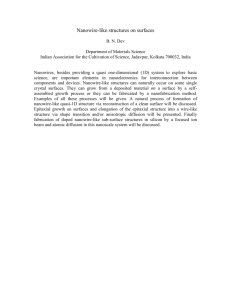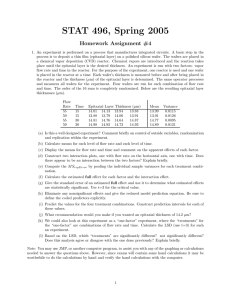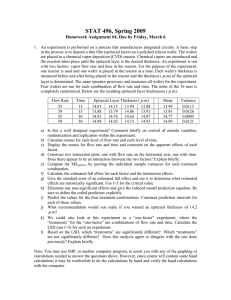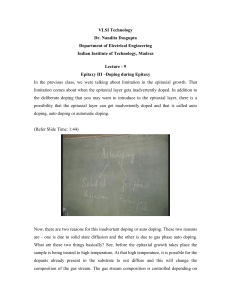MSc Project Outline
advertisement
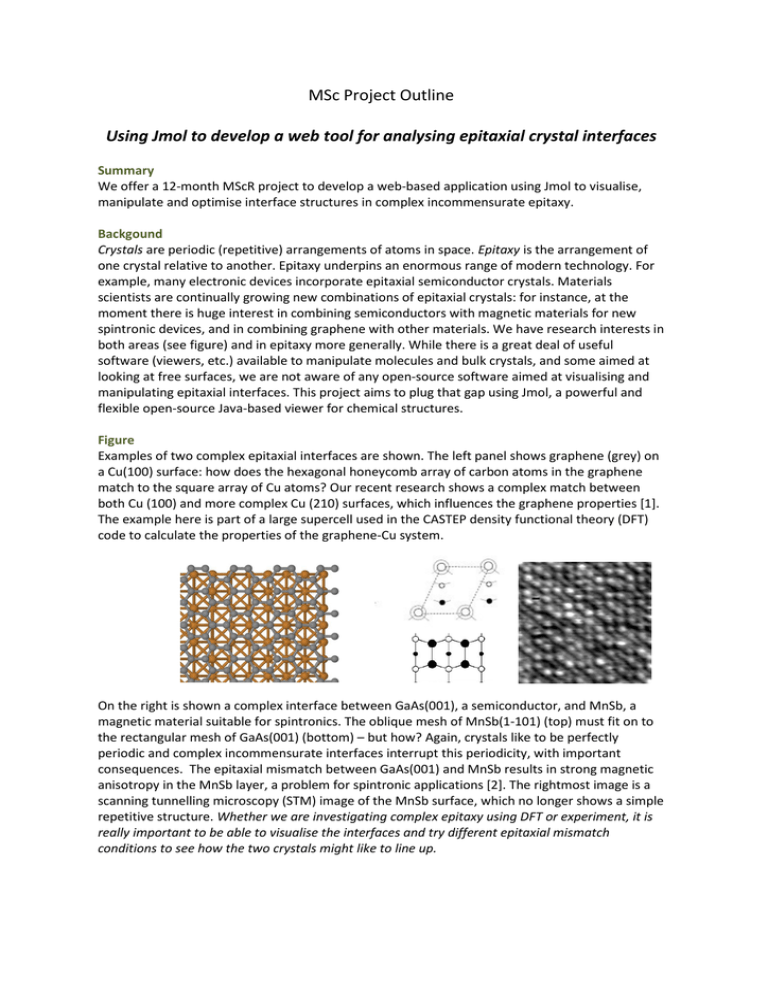
MSc Project Outline Using Jmol to develop a web tool for analysing epitaxial crystal interfaces Summary We offer a 12-month MScR project to develop a web-based application using Jmol to visualise, manipulate and optimise interface structures in complex incommensurate epitaxy. Backgound Crystals are periodic (repetitive) arrangements of atoms in space. Epitaxy is the arrangement of one crystal relative to another. Epitaxy underpins an enormous range of modern technology. For example, many electronic devices incorporate epitaxial semiconductor crystals. Materials scientists are continually growing new combinations of epitaxial crystals: for instance, at the moment there is huge interest in combining semiconductors with magnetic materials for new spintronic devices, and in combining graphene with other materials. We have research interests in both areas (see figure) and in epitaxy more generally. While there is a great deal of useful software (viewers, etc.) available to manipulate molecules and bulk crystals, and some aimed at looking at free surfaces, we are not aware of any open-source software aimed at visualising and manipulating epitaxial interfaces. This project aims to plug that gap using Jmol, a powerful and flexible open-source Java-based viewer for chemical structures. Figure Examples of two complex epitaxial interfaces are shown. The left panel shows graphene (grey) on a Cu(100) surface: how does the hexagonal honeycomb array of carbon atoms in the graphene match to the square array of Cu atoms? Our recent research shows a complex match between both Cu (100) and more complex Cu (210) surfaces, which influences the graphene properties [1]. The example here is part of a large supercell used in the CASTEP density functional theory (DFT) code to calculate the properties of the graphene-Cu system. On the right is shown a complex interface between GaAs(001), a semiconductor, and MnSb, a magnetic material suitable for spintronics. The oblique mesh of MnSb(1-101) (top) must fit on to the rectangular mesh of GaAs(001) (bottom) – but how? Again, crystals like to be perfectly periodic and complex incommensurate interfaces interrupt this periodicity, with important consequences. The epitaxial mismatch between GaAs(001) and MnSb results in strong magnetic anisotropy in the MnSb layer, a problem for spintronic applications [2]. The rightmost image is a scanning tunnelling microscopy (STM) image of the MnSb surface, which no longer shows a simple repetitive structure. Whether we are investigating complex epitaxy using DFT or experiment, it is really important to be able to visualise the interfaces and try different epitaxial mismatch conditions to see how the two crystals might like to line up. Basic goals 1. Create a Jmol-based web page able to display and manipulate two large, thin crystals in order to simulate an incommensurate epitaxial interface. The web site should be easy to use, exploiting Jmol’s extensive capabilities in file format acceptance, display options, etc. 2. Develop interactive (on-the-fly) calculation of the “interaction” between the two crystals as they are moved relative to one another, subject to epitaxial constraints. This interaction should be simple and generic, and could be based on atomic distances or on van der Vaals radius overlap using the new contact function in Jmol. 3. Develop an optimisation routine to automatically find extrema in the chosen interaction, subject to epitaxial constraints. 4. Extract longer-range repeat units from the resulting mismatch structure (Moiré pattern). 5. Apply these capabilities to systems of interest such as complex spintronic interfaces and graphene or hexagonal BN on metal crystals. Further goals 1. Extend the crystal-crystal interaction to include empirical potentials for more well-known material systems (e.g. mainstream semiconductors, metal-metal systems). 2. Extend the crystallography to include in-plane strain (possibly anisotropic) and misfit dislocation arrays. Other details This 12-month research project is suitable for the degree of MSc by Research (MScR). Candidates should have an honours degree or equivalent in a suitable physical science, mathematics or computer science. Experience with Java or open source development is an advantage. A good knowledge of basic crystallography is also important. The project would suit students who are keen to gain experience in open source coding, web development and scientific computing and who also have an interest in materials science. Financial support is not usually available for MScR projects although the Postgraduate Admissions Tutor can advise on possible sources of funding. We would expect to support travel and subsistence for at least one research conference and postgraduate workshop during the project. We expect this work will lead to a peer-reviewed publication describing the web tool and its application. Supervisors Dr. Gavin Bell Dr. David Quigley Surface, Interface & Thin Film Group Theory Group and Centre for Scientific Computing Support and guidance will also be available from the very active Jmol development and user community and from Professor Bob Hanson (St. Olaf College, USA). References Jmol: CASTEP: [1] [2] http://www.jmol.org http://www.castep.org/ N.R. Wilson et al., Nano Research 6 (2013) 99. S.A. Hatfield and G.R. Bell, Surf. Sci. 601 (2007) 5368.
